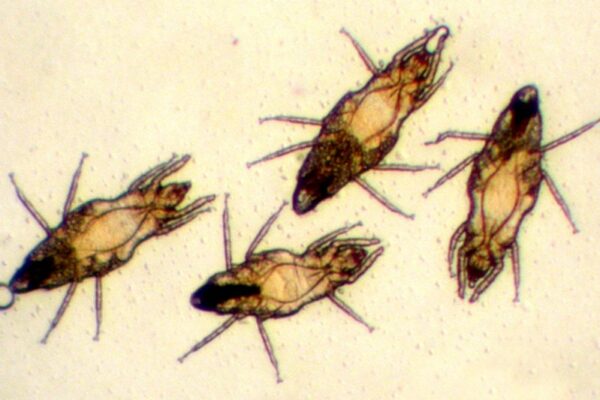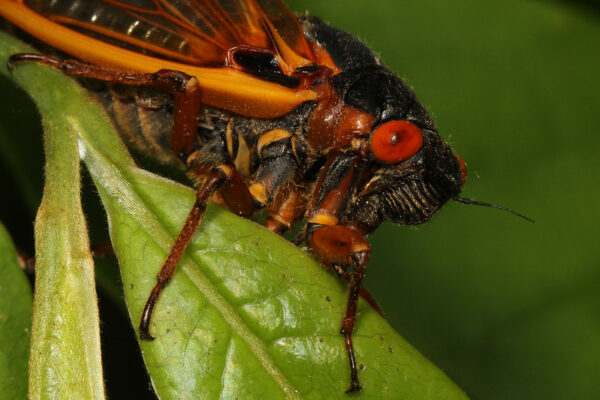
(Updated at 3:45 p.m.) Fairfax County residents are itching to understand the culprit behind weird skin reactions, possibly linked to bug bites, that have been reported throughout the D.C. region this summer.
As first reported by Tysons Reporter’s sister site ARLnow, people in Northern Virginia and beyond are finding itchy red marks on their skin that are not quite mosquito bites and may be linked to oak leaf itch mites, an arachnid that’s nearly invisible to the naked eye.
Dr. Amir Bajoghli, a dermatologist who sees patients in McLean and Woodbridge in his Skin & Laser Dermatology offices, says he has seen an increase in the number of patients with this kind of issue, often involving raised red bumps or tiny blisters. The bumps can look like acne and be intensely itchy, similar to poison ivy.
“Because of all the cicadas we had, [the mites] were basically feasting on the eggs,” Bajoghli said, noting the mites can fall from trees and be carried by wind. “Patients have even been telling me it’s worse than their experience with poison ivy.”
Oak leaf itch mites might cause red welts and affect people not only outdoors, but also indoors, potentially entering through window screens.
They typically feed on the larvae of small flies that form on leaves in oak trees. But local health officials suggest this year’s cicada emergence may be a factor, giving oak leaf itch mites another source of food from the cicada eggs laid in trees.
Still, Fairfax County health officials stressed that there’s no confirmation that the oak leaf itch mite is the cause of the bites, saying “it’s only a suspected cause at this time.”
“Although we are not certain what may be causing these bites, one of the suspected causes is the microscopic Oak Leaf Itch Mite,” Joshua Smith, the environmental health supervisor of the Fairfax County Health Department’s Disease Carrying Insect Program, said in a statement. “This mite has been presumptively associated with itchy bites in other regions of the U.S.”
States from Illinois to Texas have observed apparent outbreaks of the mite throughout recent decades.
“Most puzzling was the lack of any insect being seen or felt during the act of biting,” a research paper on a 2004 outbreak in Kansas noted.
Bajoghli, the dermatologist, recommends hydrocortisone as a starting point for treatment, which people can obtain without a prescription.
If that’s insufficient, doctors and dermatologists can provide prescription-strength remedies. He said over-the-counter antihistamines are also somewhat helpful.
“People can best protect themselves by limiting their time from under infested trees and by immediately removing and laundering clothing and then showering,” Penn State Extension researcher Steve Jacobs wrote in a patient-focused guide.
Whether the skin reactions involve that mite or something else, the Fairfax County Health Department has several recommendations for steps people can take to prevent problems with mosquitoes, ticks, and other pests:
- Use repellents. Products registered with the Environmental Protection Agency and recommended by the Centers for Disease Control and Prevention have active ingredients that include DEET, IR3535, picaridin, and more.
- Wear long pants and long-sleeve shirts outdoors.
- Shower after outdoor activities, washing away crawling ticks as well as doing a tick check.
- Launder clothes worn for outdoor activities. Ten minutes in the dryer on high heat will kill ticks on clothing.
- Avoid scratching bites. A cold compress or other products may help relieve itchiness.
People with questions and concerns are encouraged to talk with their health care provider.
A teenager born when the Brood X cicadas last emerged is now running a business to help people handle these creatures’ unusual life cycles.
With her older brother’s help, McLean High School student Michelle Martinkov started Cicada Defender to sell netting and other products and services to assist people during the cicada emergence and mating season, which happens on this magnitude only once every 17 years.
Michelle notes her parents, who immigrated to the U.S., always joked that she was a cicada baby, telling her stories of trillions of cicadas emerging seemingly overnight.
“For 17 years I have been excitedly waiting to finally experience what my parents were talking about,” she told Tysons Reporter.
She started the business with help from friends and other workers, setting up protective nets for cicadas that lay eggs on vulnerable young trees and providing clean-up services for exoskeletons left behind.
Cicadas shed their exoskeletons, a protective covering, before they take flight. They live above ground for only a few weeks to fly and mate before they die off. The buzzing that has filled the Fairfax County air over the past couple of weeks are calls to signal their availability to potential mates.
Eggs deposited on trees will hatch after about six weeks, fall to the ground, and then burrow into the soil, remaining underground for another 17-year cycle.
“I started Cicada Defender to learn about entrepreneurship and e-commerce and to spread awareness about Brood X,” Michelle said. “My goal with Cicada Defender is to see how many homes/businesses we can help and how much of our online presence we can expand over the next two months of the emergence.”
The Environmental Protection Agency advises against using pesticides, saying they don’t help stop the massive numbers of insects that will continue to come and could harm people and other insects and animals that eat cicadas, including pets.
In addition, cicadas themselves don’t pose any danger to people and, in fact, play an important environmental role. Along with providing fodder for animals like birds, they can aerate lawns, improve water filtration in the ground, and add nutrients to the soil as they decompose, the EPA notes.
While they can damage young trees, the insects can’t harm larger, more established trees, and they will not eat leaves, flowers, fruits, or garden produce, making it unnecessary to cover them, according to the EPA.
Michelle says Cicada Defender uses a “highly sustainable” process with no pesticides or heavy machinery.
“All we use is netting, shovels, trash bags, buckets, and occasionally a ladder when necessary,” she said.
She hopes to help the community by educating them about cicadas and providing some support through the experience.
“Something we are extremely proud of is that we intend to donate a portion of our proceeds to local plant nurseries,” Michelle said. “We feel this gives back to our community and provides a business a greater sense of purpose.”
Photo courtesy Judy Gallagher/Flickr


